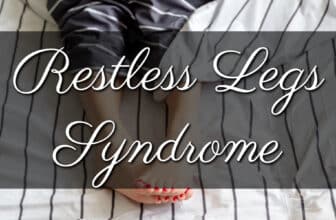The most common source of lower back and leg pain is sciatica. The sciatic nerve is the largest nerve system in your body. When a part of your sciatic nerve becomes irritated or pinched, usually in the lumbar or sacral spinal region, it can result in sciatica and radiating pain down your leg. The pain produced by sciatica can often make it difficult to drift off and hard to get comfortable while lying down. However, we’ve compiled a list of eight tips to help teach you how to sleep with sciatica more comfortably. These may not relieve your sciatic pain entirely, but they will definitely help put you in the right position for a better night’s slumber and a less painful morning.
How Does Sciatica Affect Sleep?
Sciatica interacts with the quality of sleep you get due to the pain and discomfort it causes. It is not uncommon for sciatica to flare up at night and in the morning. Why does sciatica get worse at night? Mostly because it has built up pressure, strain, and stress throughout your entire day and is ready for some relief. Ideally, sleeping will provide the rest and recovery you need but only if you cater to your sciatic pain in the process.
Eight Easy to Follow Tips on How to Sleep with Sciatica
We compiled this list of healthy tips to explain how to sleep with sciatic nerve pain more comfortably so you can wake up feeling your best every day. Choose a few to try tonight and keep experimenting with them until you find what works best for you and your body’s specific needs.
1. Your snooze position plays an important role in relieving sciatic nerve pain.
When you experience lower back pain or have sciatica, one of the hardest parts of coping can be finding a comfortable sleeping position. However, it is really important that you do so because it has a strong and direct relation to the amount of pain you will experience in the morning and throughout the next day.
Take note of the following sleeping positions and its effects:
a. Side Sleeping
Sleeping on your side is often the best sleeping position for sciatica. This particular position facilitates superior pressure relief right where you need it most – in your low back and lumbar region. Side snoozing also promotes healthy spinal alignment when done properly. Resist the urge to let your top leg roll forward so it can rest on your mattress. This causes unnecessary twisting of the spine which can further pinch the sciatic nerve and lead to increased discomfort or pain.
Instead, keep your legs stacked and place a pillow between your knees or settle in with a body pillow to help keep everything in the correct position. It’s another proven option on how to sleep with sciatica leg pain.
It is common for one side of your body to experience more pain than the other when it comes to sciatica and low back pain. To avoid further discomfort always rest on the least painful side. If neither side proves comfortable, you may want to choose a different position entirely.
b. Lying Flat on Your Back
Sleeping on your back may or may not be accommodating to sciatica (as we mentioned earlier, everyone’s case is different). If you try snoozing on your back, make sure you place a pillow underneath your knees. Elevating your knees will help relieve pressure on your spine which is very good for the low back. You may also want to try placing a small pillow or rolled-up towel beneath your lower back. This is to relieve even more pressure while simultaneously providing the extra support you need.
Do not try sleeping on your back without the additional pillow or pillows for support as this will increase stress on your spine and sciatic nerve. Resting on your back could also exacerbate sleep apnea and snoring, making it a poor choice for some.
c. Tummy Sleeping
Sleeping on your stomach is highly discouraged if you have sciatica. Stomach sleeping causes strain and unnecessary twisting of the neck and back. It also places excess pressure on your stomach, pelvis, and hips. Avoid this position entirely to get as much good night’s rest as possible.
2. Settle on a firm, supportive mattress or surface.

When it comes to sciatica and sleeping, don’t overlook your bedding. A firm and supportive surface is key to promoting healthy spinal alignment. Furthermore, increased pain and discomfort will be avoided because of proper support. Do not rest on a soft mattress. Choose a medium-firm to firm mattress which will provide the features and comfort you need to accommodate your sciatica.
Additional traits to prioritize when purchasing a mattress that is ideal for sciatica:
- Temperature regulation
- Edge support
- Motion isolation
- Mattress height
- Additional lumbar support
If you do not have the right mattress or cannot afford to buy a new one right away, you may also want to consider sleeping on the floor with some minimal padding. The floor will definitely give your stressed spine and sciatic nerve the support it needs to facilitate active recovery. Some people who suffer from sciatica sleep on the floor and claimed to have experienced great relief. This could make a world of positive difference for you.
3. Use a pillow that provides ample neck support.
Supporting your neck while you slumber will also help relieve sciatic pain. Similar to drifting off on the floor, sufficient support is the key to proper alignment throughout your entire spine. Using a pillow that is too soft or too fluffy for your body type will only cause more strain to your spine and more pain. Considering the connection between your spine and sciatic nerve, a great pillow will serve you well.
4. Take a warm, relaxing bath before going to bed.
Finding a way to relax and unwind is an important part of preparing for bed if you have sciatica, and a nice bath is a great idea to accomplish this. Soaking in a warm tub will initiate the release of pain-relieving endorphins and will relax the muscles surrounding your sciatic nerve. Warm water is best for this form of relaxation. If the water is too hot or too cold it can be overstimulating and may produce results far different from what you desire.
5. Use ice particularly during painful days.
When pain intensifies and gets a bit too much for comfort, you may find relief in applying ice on your painful spots. Placing a bag of ice or a cold pack on the lower spine or buttocks can help reduce swelling, which will also help lessen that shooting pain. Check with your doctor to see how often and for how long they recommend using ice if you opt for this pain management.
6. Stretch out your tensed muscles before going to bed.

Stretching can be a big part of learning how to sleep with lower back pain and sciatica comfortably. Light stretching can help elongate and relax your muscles and joints to get you ready for a night of slumber. Stretches that cater to your legs, hips, and lower back are best for relieving sciatic pain and getting you to drift off faster. The increased flexibility will also help you cope with sciatica throughout the day by making movements less stressful and more fluid.
7. Get massages that cater to sciatic nerve pain.
Massages are often viewed as a luxury but they work miracles in relieving sciatic nerve pain. Your doctor will most likely recommend a great therapist who specializes in sciatica massages. He may also encourage you to get routine massages for preemptive maintenance and pain management.
There are also some massages you can do to yourself at home which could help you fall asleep faster and more comfortably. Consider adding one or more to your bedtime routine to minimize the pain or discomfort.
a. Seated Lower Back Massage
Using your palms and thumbs rub your lower back toward your spine. Follow this with downward motions towards and onto your buttocks. Next, wrap your fingers around your waist and apply pressure toward your spine. If you experience pain, reduce the pressure promptly.
b. Spinal Alignment Massage Lying Down
While lying on your back with your knees bent, use your fists to apply pressure on either side of your lower back. Press your knuckles into your back for a couple of minutes with your body weight resting on top of your fists. Follow this by resting in a fetal position for a couple of minutes.
8. Talk to your doctor about pain-relieving creams, patches, and more.
Consulting your doctor about pain management is always a good idea, especially if none of our other tips are providing you with the comfort and rest you need. Your doctor may want to recommend pain-relieving creams or patches which have proven to be effective for many people. They may also want to discuss further treatment options and possible causes for your discomfort other than sciatica.
Finding a Regular Good Night’s Sleep with Sciatica
This concludes our tutorial on how to sleep with sciatica. Keep in mind that sciatic nerve pain affects everyone differently. Therefore, some of these tips may be quite effective at relieving pain for you, while others may not seem to help at all. We recommend experimenting with a combination of the preceding tips until you find the best way to sleep with sciatica for your specific condition. Also, try the techniques for at least three days before deciding if these are the right options for you or not. Delayed effects are not uncommon.
What are you waiting for? Get started tonight!





